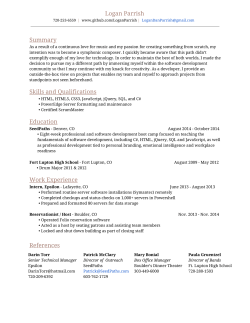
Cloud Service Provisioning with Epsilon and Chef MANAGE CONFIGURATION WITH CHEF
Cloud Service Provisioning with Epsilon and Chef MANAGE CONFIGURATION WITH CHEF AUTOMATE WITH EPSILON INTEGRATE EPSILON AND CHEF Chef is one of the leaders of the configuration management space. It provides a framework that “makes it easy to deploy servers and applications to any physical, virtual, or cloud location”. The configuration of each node in an organization is defined in ‘cookbooks’ (and ‘recipes’) and stored on a chef server, which acts as a repository for configuration data. Epsilon is an agentless, end-to-end IT automation platform that you can use to define and build workflows that orchestrate, manage, and report on a datacenter. The key advantage of Epsilon is its ability to seamlessly integrate with most industry-leading applications, such as email systems, databases, ticketing systems, status monitors, and build and deployment tools. Configuration management is only a part of IT infrastructure management in an organization. Epsilon adds value to Chef by integrating with other enterprise software to automate IT processes. Apart from the provisioning and configuration of servers, typical service provisioning processes include getting approvals for infrastructure and integration with other enterprise software, such as a CMDB or a Service Desk. Relevant cookbooks are picked by chef_client, which runs on the nodes, and applied to respective nodes. This framework allows the modelling and management of complex IT infrastructure. Chef has a large community of users who create cookbooks for solving common - and some very complex - problems. With Epsilon in their IT, an organization can take its operations beyond deploying and configuring machines, and convert it into a fully-automated IT process management. USE CASE: AUTOMATED SOFTWARE STACK DEPLOYMENT USING EPSILON 1 Idea Device Technologies Pvt. Ltd. info@ideadevice.com | India – 1 800 200 5393 | US – 1 800 200 5393 | Singapore – +65 9857 4993 Cloud Service Provisioning with Epsilon and Chef Consider the scenario where an IT team provides support to multiple sub-teams, which work on various software stacks, LAMP, Java, and so on. The team has developed Chef cookbooks that spin up and configure development, test, and production setups for each of these teams. Typically, after an engineer creates a service request for a development environment, the IT team: 1. Pick up the ticket from the Service Desk. 2. Check the available capacity (both budget, as well as infrastructure). 3. Look up the reporting hierarchy and get the requisite approvals. 4. Use the provisioning system to provision the nodes. 5. Use Chef to deploy the appropriate configuration to the nodes. 6. Test the deployment. 7. Update the CMDB. 8. Send the engineer a notification with details about the deployment. 9. Close the Service Desk ticket. Apart from step 5 and parts of steps 4 and 6, the process is completed outside the Chef platform. The diagram shown above depicts a completely automated process flow after Epsilon is integrated with Chef; the entire process can be written as a workflow in Epsilon. Backed by Epsilon workflows, a single ‘service catalog’ can be created on the service desk, which models the IT processes endto-end and internally uses Chef to deploy and configure servers. 2 Idea Device Technologies Pvt. Ltd. info@ideadevice.com | India – 1 800 200 5393 | US – 1 800 200 5393 | Singapore – +65 9857 4993
© Copyright 2025
















